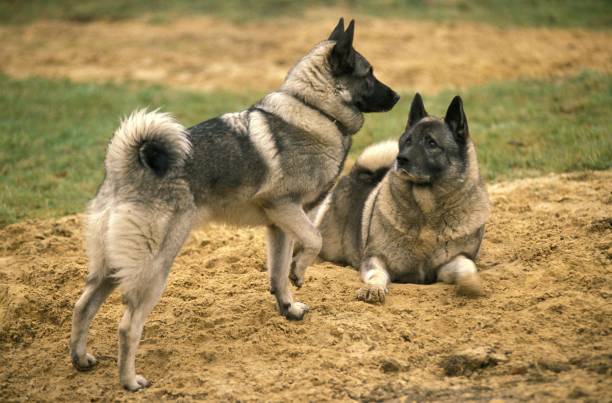Norwegian Elkhound

Breed History:
The Norwegian Elkhound is one of the oldest Northern spitz-type breeds, with roots tracing back over a thousand years to the time of the Vikings. This sturdy and fearless dog was historically used for hunting large game, especially moose (referred to as "elg" in Norwegian), bears, and wolves in the rugged Scandinavian wilderness. Known for its courage, keen scenting ability, and ability to trail game silently and then bark to alert hunters, the Elkhound played a vital role in Norway’s hunting traditions.
More than just a hunter, the Elkhound also served as a guardian and companion to its human family, living alongside them in harsh, isolated conditions. Its loyalty, intelligence, and resilience have made it a cherished national symbol in Norway, and the breed remains a capable hunting dog and devoted family companion in modern times.
|
Gender |
Height |
Weight |
|
Male |
71 cm |
60–70 kg |
|
Female |
66 cm |
45–55 kg |
Size – Medium
Life Expectancy: 12–15 years

Breed Appearance:
The Norwegian Elkhound has a compact and muscular build, designed for stamina and agility in difficult terrain. It has a thick, weather-resistant double coat that is gray with black-tipped guard hairs, giving it a classic wolf-like appearance. The undercoat is soft and dense, providing insulation during Norway's cold winters.
The breed’s head is broad and wedge-shaped, with dark brown, oval eyes that reflect intelligence and alertness. Its erect, pointed ears and curled tail carried tightly over the back are hallmarks of spitz breeds. The Elkhound's overall look is one of strength, readiness, and endurance, traits that reflect its origins as a rugged working dog.
Breed Type – Family/Guard:
The Norwegian Elkhound is a loyal and protective breed, known for its devotion to family and strong guarding instincts. While not aggressive, it is naturally suspicious of strangers and will bark to alert its owners to unfamiliar activity, making it an effective watchdog. The breed is affectionate with its family, particularly children, and thrives on companionship and involvement in daily life.
This breed does not do well when left alone for long periods and prefers to be part of a pack, whether that’s other dogs or people. It can be headstrong and independent, but its affectionate and spirited nature makes it a valued family member when given proper training and leadership.

Training:
Intelligent and bold, the Norwegian Elkhound is capable of learning quickly, but its independent streak can pose challenges for novice trainers. The breed often prefers to think for itself, a trait that served it well as a solo-tracking hunting dog. Consistent, firm, and positive training methods are necessary to harness the Elkhound's intelligence without triggering stubbornness.
Early obedience training and socialisation are essential to help the Elkhound learn to interact calmly with other animals and people. While the breed may not always be eager to follow commands, it responds well to reward-based training and appreciates mental challenges. Patience and consistency are key to success with this self-reliant breed.
Health & Care:
The Norwegian Elkhound is generally a healthy breed with a long lifespan of 12 to 15 years. Thanks to its robust working heritage, it is less prone to many genetic issues than some modern breeds. However, it can still be susceptible to conditions like hip dysplasia, progressive retinal atrophy (PRA), and hypothyroidism.
Maintaining a healthy weight through proper diet and exercise is important to prevent stress on the joints. Routine veterinary checkups, vaccinations, and parasite control are essential for long-term health. Owners should also monitor for early signs of joint or eye issues as the dog ages, especially if it remains very active in later years.

Living Conditions:
The Norwegian Elkhound adapts well to various living situations, but it thrives in homes with access to a yard or natural spaces where it can explore and expend energy. It is not ideal for apartment life unless the owner is highly committed to daily physical and mental activity. The breed loves being part of a family unit and does best when it has regular companionship and stimulation.
This breed can tolerate cold climates exceptionally well thanks to its dense coat, but it may struggle in hot, humid environments. In warmer weather, care must be taken to provide shade, fresh water, and reduced activity during peak heat hours. The Elkhound also tends to bark frequently, which should be managed with training and environmental enrichment.
Exercise:
The Norwegian Elkhound is a high-energy breed that requires plenty of daily exercise to stay fit and happy. Long walks, hikes, play sessions, and opportunities to run off-leash in safe areas are essential to meet its activity needs. As a former hunting and working dog, the Elkhound excels at physical tasks and thrives when it has a job to do.
Mental exercise is equally important. Puzzle toys, scent games, or agility training help prevent boredom and reduce undesirable behaviours like excessive barking or digging. Without enough stimulation, the Elkhound can become restless and destructive. A bored Elkhound will often find ways to entertain itself, which may not align with the owner's preferences.
Grooming:
The Norwegian Elkhound’s thick double coat requires regular grooming to remain healthy and clean. Brushing at least twice a week is needed to remove loose fur and prevent matting, especially during the heavy shedding seasons in spring and fall. During these periods, daily brushing is recommended to manage the coat.
Bathing should be infrequent, as the coat naturally repels dirt and water. Over-bathing can strip the coat of its oils. Regular ear cleaning, nail trimming, and teeth brushing should also be part of the grooming routine. The Elkhound is a naturally clean dog but will shed significantly, so owners should be prepared for regular vacuuming and coat maintenance.

Advantages:
-
Loyal and protective family companion with strong guarding instincts
-
Energetic and playful, especially good with children
-
Naturally clean and low odor compared to many breeds
-
Excellent endurance and stamina; great for hiking and outdoor activities
-
Long lifespan and generally robust health
-
Adaptable to cold climates and harsh environments
Disadvantages:
-
Heavy seasonal shedding requires consistent grooming
-
Can be stubborn and independent; needs an experienced or patient trainer
-
May bark excessively if not properly trained or mentally stimulated
-
Needs significant daily exercise to prevent behavioural issues
-
Not ideal for hot climates; prone to overheating
-
Can be territorial and reserved with strangers without early socialisation

